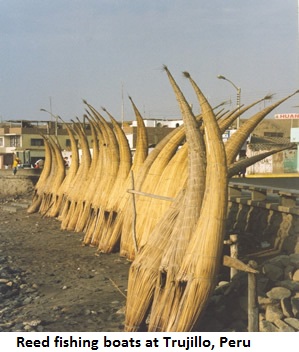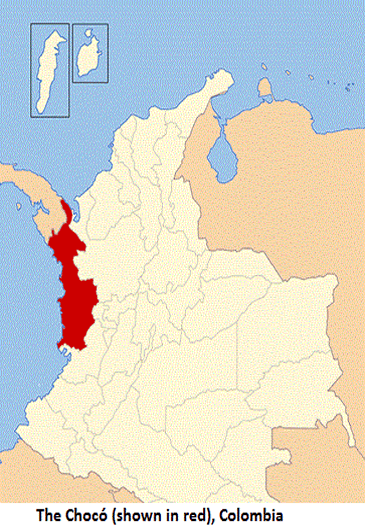Pacific Coast
1. Introduction
Leaving aside Chile, which for historical
reasons forms a special dialectal enclave, the speech of much of the South
American Pacific  coast exhibits a broad uniformity, in phonetic terms at least.
Although the major focal points during the colonial period were located away
from the Pacific (with the notable exception of Lima), some coastal cities,
such as Trujillo in Peru and Guayaquil in Ecuador, are now major centres of
population.
coast exhibits a broad uniformity, in phonetic terms at least.
Although the major focal points during the colonial period were located away
from the Pacific (with the notable exception of Lima), some coastal cities,
such as Trujillo in Peru and Guayaquil in Ecuador, are now major centres of
population.
Afro-Hispanic communities are sprinkled along the coast, from southern Peru to northern Colombia. In colonial times black slaves were employed in mines and on plantations in the Andes and after the abolition of slavery many ex-slaves or the descendants migrated westward towards the Pacific coast. In some areas, particularly in parts of Colombia, the black population is demographically dominant; a case in point is the low-lying Chocó area, which was oiginally shunned by settlers of European origin.
2. Phonetics and phonology
Like
virtually all of non-Andean South America, the Pacific coast is an area in
which [h] and Ø (i.e. elision) are statistically frequent variants
of the syllable-final (s) variable. As is usually the case in dialects of this
type, Ø is more stigmatized than [h], and
both variants are more stigmatized in prevocalic (word-final) position than in
preconsonantal position. This positional constraint appears to be weakening
among younger speakers, however.
As in the Caribbean, the usual variant of (x) is [h]; thus [paha] paja ‘straw’, for example.
Word-final /n/ is commonly velarized, although when the following word begins with a consonant, this process may be checked by the general tendency in Spanish for preconsonantal nasals to have the same place of articulation as the following segment (see neutralization). Nevertheless, preconsonantal velarization, as in [eŋtukasa] en tu casa ‘in your house’, is by no means uncommon.
At the lower end of the socio-economic spectrum, syllable-final liquids may undergo some of the processes outlined for Andalusia, the Canaries and the Caribbean (specifically: [l] to [ɾ] modification and vice-versa, and elision).
Finally,
features that are typical of creole Spanish may be encountered in vernacular
dialects in coastal areas of Colombia,  particularly in the Chocó area. In
particular, /d/ may be realized as [ɾ], as in [maɾuɾo] maduro ‘mature’ and [moɾo] modo ‘way’ and /k/ as the glottal stop [ʔ]: [lakasaʔuɾal] la
casa cural ‘the priest’s house’.
particularly in the Chocó area. In
particular, /d/ may be realized as [ɾ], as in [maɾuɾo] maduro ‘mature’ and [moɾo] modo ‘way’ and /k/ as the glottal stop [ʔ]: [lakasaʔuɾal] la
casa cural ‘the priest’s house’.
3. Morphology
In terms
of the Pacific coast, voseo is
widespread in Ecuador (except in Guayaquil and Esmeraldas city), not uncommon
in Colombia and almost non-existent in Peru. In the present indicative, the
accompanying verb forms are usually oxytone with monophthongal endings (cantás, comés, subís), but
throughout the rest of the verb paradigm the vos verb forms are identical to those that go with tú in standard Spanish. Some social
stigma attaches to voseo but, in
Ecuador at least, it is deeply entrenched at the vernacular level.
4. Syntax
Spanish on the Pacific coast is not
syntactically distinctive. The same phenomena are likely to be encountered as occur
in general in the countries in question.
The one notable departure from this state of affairs concerns the clause-final doubling of the negative particle no, as in the example below:
(1) No como carne no.
‘I don‘t eat meat.’
This is essentially a coastal feature and is common among Afro-Hispanic speakers. It may well have a creole origin (see Pearl and Schwegler 1998).
5. Lexicon
The coastal lexicon in Colombia, Ecuador and Peru is not particularly different from the vocabulary of the corresponding inland varieties. Words that are common in these countries but are not strongly associated with inland areas include furminga ‘confusion/crowd of people’, chanfaina ‘job’, mono ‘blond’, guineo ‘banana’, chino ‘person’, jebe ‘rubber’, chévere ‘great/cool’, chancho ‘pork’, charol ‘tray’, chibolo ‘kid’, guaraca ‘catapult/whip’, manganzón ‘lazy’, montubio ‘coastal farmer’, quiñar ‘to chip’, al tiro ‘straight away’.
References
Perl, Matthias and Armin Schwegler (eds.) 1998. América negra: panorámica actual de los estudios lingüísticos sobre variedades hispanas, portuguesas y criollas. Frankfurt: Vervuert.